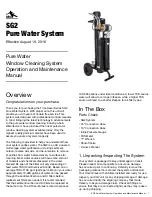
3 - Planning and Preparation
DynaPro Go| Handheld PIN Pad Device with MSR/Contact/Contactless | Installation and Operation Manual
Page 16 of 60 (
D998200129-10
)
3
Planning and Preparation
The guidelines in the following sections will assist management and network administrators in planning
for the physical and network requirements of deploying and using DynaPro Go. The most effective way
to ensure smooth deployment of a solution is to consider these factors before receiving the device.
3.1
Logistical Planning
•
Determine what type of
host
DynaPro Go will connect to. This can be a computer with a USB port or
connected to a TCP/IP network that is equipped with 802.11 wireless. When planning, include any
additional support or devices required by the host and DynaPro Go, such as physical locations,
mounting, power connections, and charging cradles.
•
Determine what
software
will be installed on the host and how it will be configured. Software can
include operating system, transaction processing software, security software, and so on. Include any
additional support required by the software, such as network connections. Information about software
is provided in section
•
Configure the host software to select which combinations of magnetic stripe swipe, EMV contact card
insertion, contactless payment tap, and/or manual entry the host will direct the device to accept (see
). This decision may differ based on location, situation, and other factors,
or may be uniform across all transactions and devices and hosts you are deploying.
•
Determine how DynaPro Go will be physically
presented
to the cardholder.
•
Select which
connection type
the solution will use. Available connection types include USB and
TCP/IP over 802.11 wireless, and only one interface can be active at a time. The connection types
available in each model are listed in
Table 2-1 - Available Models and Options
•
Determine how DynaPro Go should be
configured
, and specify that configuration when ordering the
device. For example:
o
Determine whether the device should be
Always Listening
for wireless messages from the
host, or creating
Device-Initiated
connections on demand.
o
Determine whether the LCD display backlight should operate in
Manual
mode (constant
brightness) or
Auto
mode (adaptive to ambient light).
•
Select and configure a secure workstation advanced operators will use to configure and update the
device. The workstation must be configured as follows:
o
Available USB port
o
A secure means of obtaining files, either via the network (such as SFTP) or via removable
media, such as USB flash drives.
o
99510127 DYNAPRO/DYNAPRO GO/DYNAPRO MINI WINDOWS SDK INSTALL
(EXE)
installed. This software includes the
MagTek PCI PED Host App Simulator
tool
advanced operators use to configure the device.
o
It may also need a browser connection to a certificate authority (CA) for downloading
certificates.
•
Determine the
charging schedule(s) and location(s)
. For example, high-traffic mission-critical
solutions may benefit from keeping multiple devices charging for fast swap-out. Charging cradles
and accessories are available directly from MagTek. Make sure there is an adequate number of USB
wall chargers and / or USB ports available for the number of devices you are charging together, and
make sure the electrical socket-outlet at a given charging location can support the total load.
Solutions using large numbers of devices may benefit from using a large-scale universal USB charger
/ hub. Details about charging are provided in section
6.3.1 How to Charge the Battery
. Details
about maximum power consumption are provided in
















































